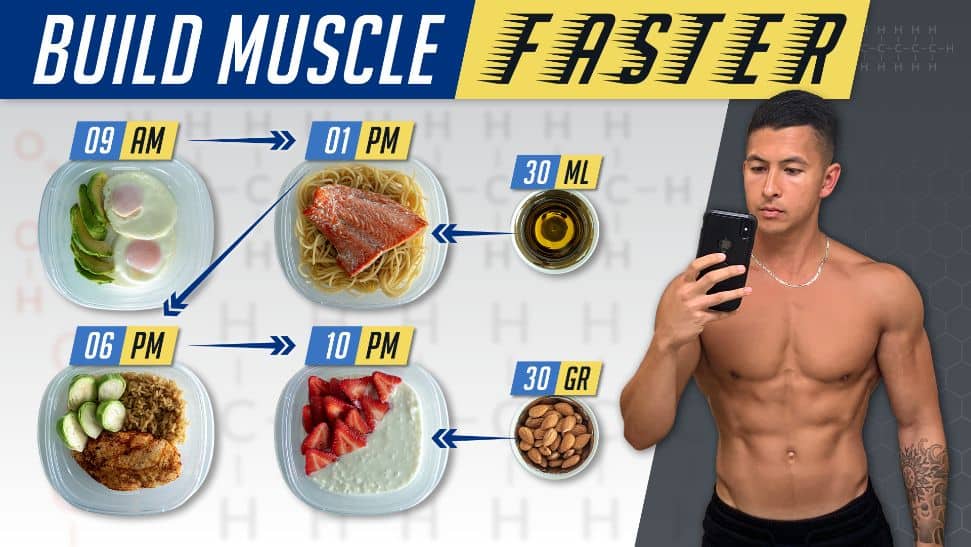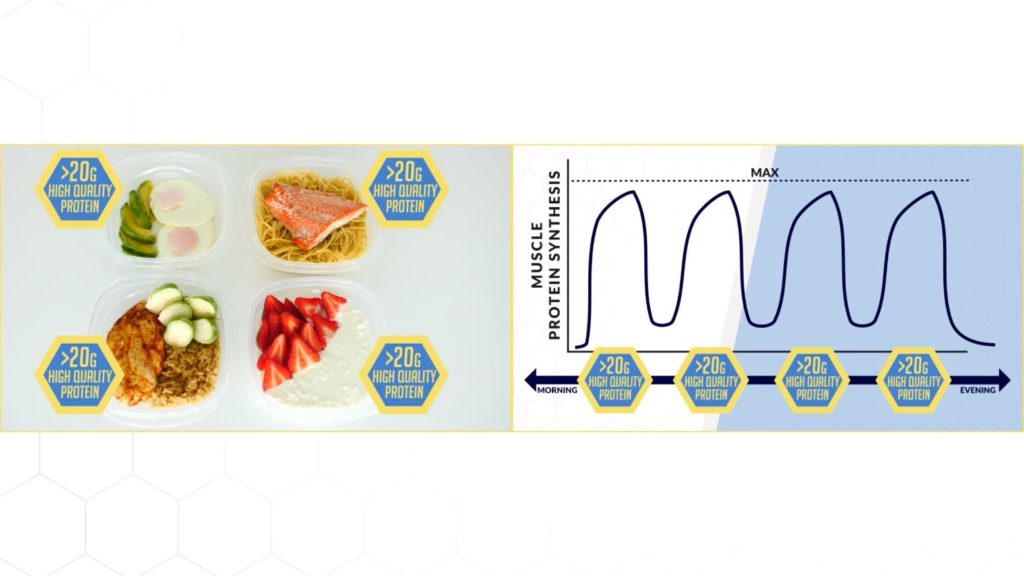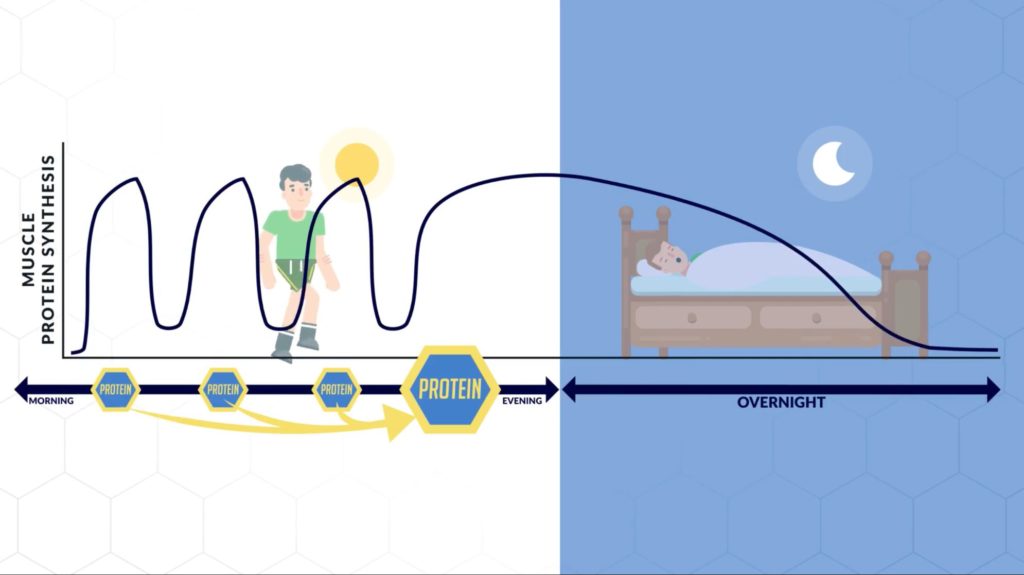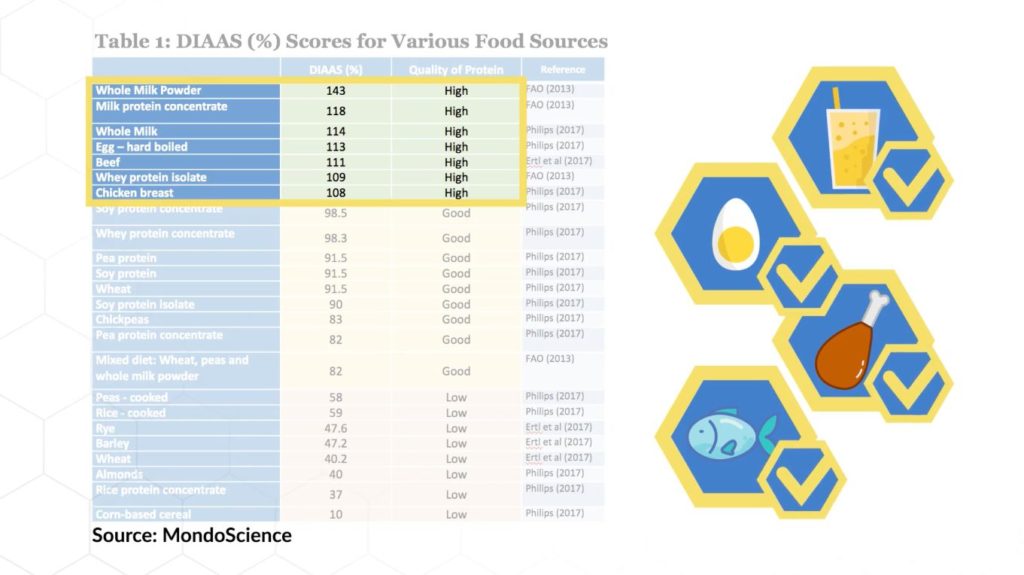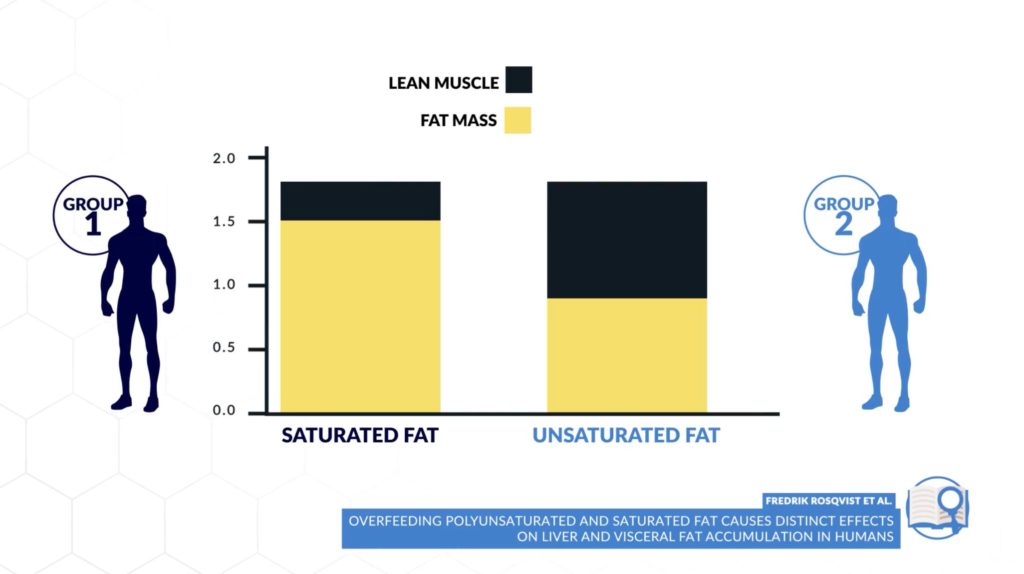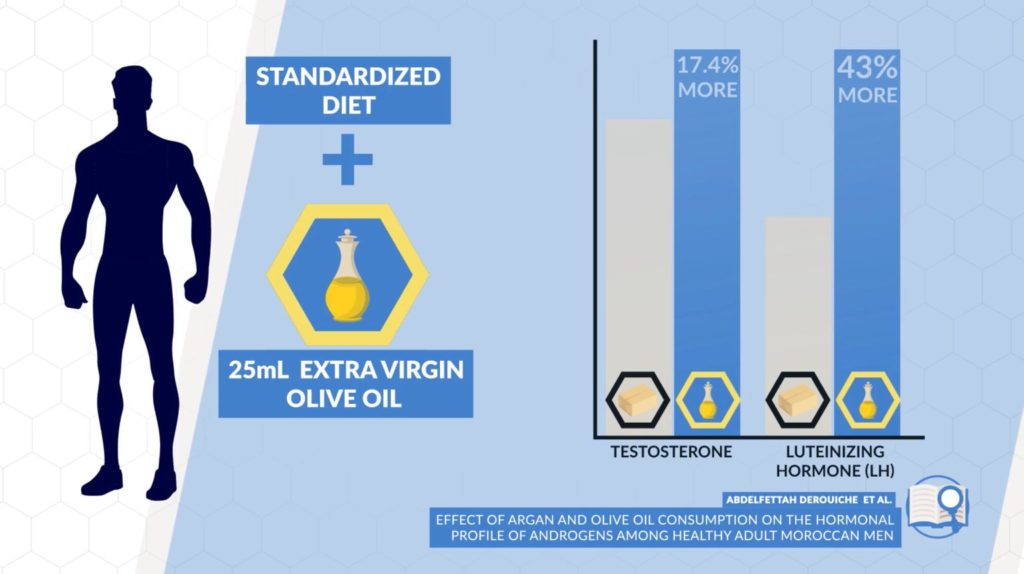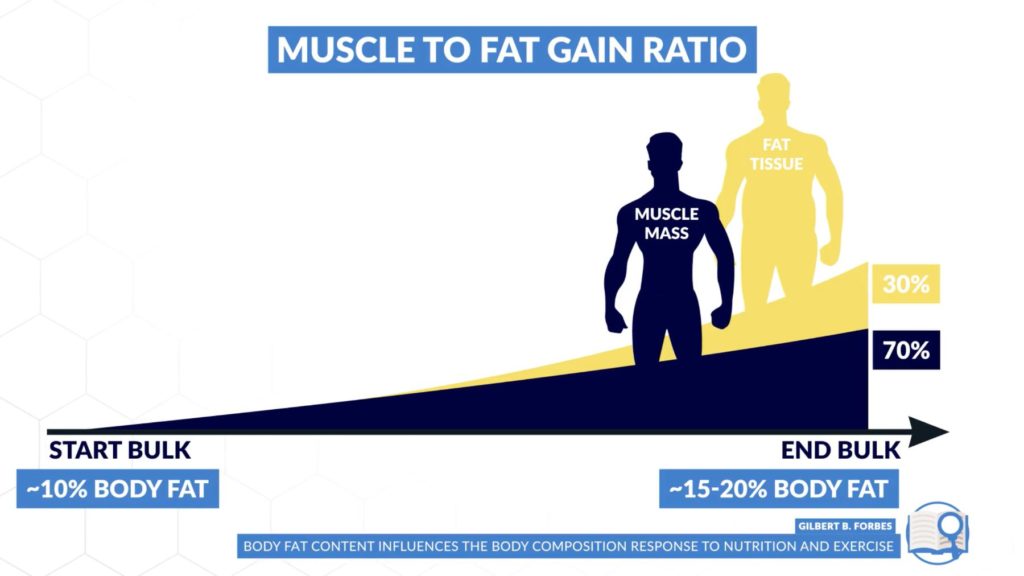What To Eat To Build Muscle Faster (The Best Bulking Meal Plan)
Maximize the resulting growth you experience from your workout by optimizing your nutrition. Find out exactly how and what to eat to build muscle in this article.
Your workouts are what provide the damage and stimulus for your muscles to grow. But the muscle building foods you eat throughout the day is what provides the fuel for your muscles to recover. And then, come back stronger and bigger. That's why it's important to find out how you can optimize your diet plan for faster growth (i.e. what to eat to build muscle faster).
So, if you’re seeking to pack on more size with your meal plan, then you need to make sure you’re accomplishing 3 things:
- Eating at a slight calorie surplus - This surplus should enable you to gain roughly 1-2% of your body weight per month
- Eating adequate protein every day - Roughly 1g/lb bodyweight OR 2.2g/kg bodyweight
- Not eating like complete crap - That means you should prioritize more whole foods and less processed foods in your diet
All these, on its own, will account for let’s say 90% of the muscle growth you experience from your bulking meal plan. But, if you guys know me, I’m all about optimization. So how can we get that extra 10%? Well, going beyond what I previously mentioned, there are a few additional things we can do with our muscle building diet.
These extras can then help speed up the muscle-building process. And in this article, I’ll show you exactly how to eat to build muscle faster. I'll also provide you with a nutrition plan for building muscle that puts this all together for you.
And as I’ve said in the past, your nutrition will hands down be the most important factor when it comes to transforming your body. I used to be completely lost as to how to approach my nutrition and I know a lot of you out there are as well. This is exactly why within my Built With Science programs, I not only cover training but also stress the importance of nutrition. In fact, I even developed a custom-built nutrition software designed to optimize your diet based on your own stats and goal. For more information:
Click the button below to take my analysis quiz to discover the best program for you:
↓
Step 1: Optimize 24-h Protein Synthesis
The first thing you’ll want to do is optimize your 24-hour protein synthesis levels. Every single meal is an opportunity to kickstart the growth and recovery process within your muscles by elevating your protein synthesis levels. So, we want to take advantage of that as best as possible. And to do so, we first need to start with the distribution of our protein.
How To Optimize Protein Distribution For Maximal Muscle Growth
So, we know based on past research that at least 20g of high quality is required to give a near-maximal increase in muscle protein synthesis. Which then lasts for a few hours, give or take, depending on the components of that meal. Meaning that ideally, we want to ensure that we’re:
- Having at least 20g of high-quality protein in each of our meals AND
- Eating them at a frequency that enables us to keep our protein synthesis levels elevated throughout the day
Rather than having a less than ideal protein distribution throughout the day. For example, some meals that undershoot the protein synthesis response. And then having some meals with excessive protein that would not further increase muscle protein synthesis past the maximum we’re already reaching.
And in fact, recent 2020 research has finally tested this theory for growth and compared the effects of:
- Evenly spreading out one’s daily protein intake into 3 meals throughout the day VS
- Skewing most of the protein into just 2 meals
They found that after 12 weeks of this, combined with resistance training, the evenly distributed protein group gained 30% more lean muscle mass as opposed to the unevenly distributed group. Which the researchers attributed to the better 24-hour muscle protein synthesis levels in the evenly distributed group.
So, how can you apply this to your diet? Well, you want to take your daily protein intake and spread that out into ideally 4-5 meals throughout the day. And you also want to make sure that each of those meals contains a minimum of 20g of protein. As this will best enable you to keep your protein synthesis levels optimized throughout the day.
Extend Your MPS Response With A Slow-Digesting Protein Before Sleep
That said, there’s still another thing we can do to optimize our 24-hour protein synthesis. We have indeed optimized it during the day. But we also need to keep in mind that the muscle building and recovery process still goes on overnight as you’re sleeping. Therefore, it makes sense to ingest an adequate amount of protein shortly before you go to bed.
Why? Because that’s the longest period you’ll go without food! And for this reason, I’d actually argue that you’d want to also bias a little more of your daily protein towards this pre-sleep meal with a slow-digesting protein. This will help extend that muscle protein synthesis response as much as possible.
In fact, research seems to agree with this. While 20g of protein gives a near-maximal increase in protein synthesis during the day, it appears that you need at least 40g of protein to get a significant increase in overnight muscle protein synthesis.
This can be done with an adequate amount of ideally a slow-digesting protein such as casein protein powder, cottage cheese, or eggs, for example. These protein sources will help further sustain that protein synthesis response overnight.
Step 2: Incorporate More “Muscle Building Foods”
The next tip here is to incorporate “muscle building foods”. I have to say, I honestly hate using that term. But research does actually suggest that there are certain good muscle gaining foods you can choose that may in fact speed up the muscle-building process.
Opt For High-Quality Protein Sources
First, you want to opt for high-quality protein sources. More specifically, you want to opt for those that are:
- High in leucine content - Leucine is the most potent amino acid at stimulating protein synthesis
- High in digestibility - This helps your body use a greater proportion of that protein for growth
Based on the summaries of various studies and literature reviews shown, we can see what protein sources best meet these criteria. At the top, whey isolate, eggs, and chicken breast, (and I’d add fish to this as well), seem to score the best. And are therefore great high-quality protein sources for you to include in your diet.
Whereas plant-based protein sources score lower on the list. This doesn’t mean that they can’t be used for growth. But as I’ve explained in past articles, they need to be eaten in greater amounts and mixed and matched with each other in order to compensate for the lower protein synthesis response we tend to see with them.
Not sure how this applies to your diet plan? Don't worry. Our 3-on-1 coaching program can help. You will not only have a dietitian to customize your nutrition plan, but also a coach to focus on your training plans - plus, there's me to answer your questions every month! You'll achieve your dream physique in record-breaking time. Sounds good? Let's get started then:
Click the button below to find out more about the 3-on-1 coaching program:
↓
Prioritize Unsaturated Fats Instead Of Saturated Fats
Another tweak you can make in your diet is opting for more unsaturated fats as opposed to saturated fats. And the reasoning behind this is partly based on a recent paper. Here, the researchers overfed 39 subjects who were on the same standardized diet with an excess of 750 calories a day. This was accomplished with either:
- Cupcakes made with saturated fat (palm oil) OR
- Cupcakes made with unsaturated fat (sunflower oil)
After 7 weeks, both groups gained similar amounts of weight. However, what’s interesting is that in the saturated fat group about 80% of the weight that was gained was fat and 20% was muscle. Whereas in the unsaturated group, only 50% of the weight gained was fat and 50% was now muscle. Although the reasoning behind this is unknown, another study did find similar results. And likely involves various differences in fatty acid oxidation and storage depending on the fat source.
Meaning that relying less on saturated fats like cheese, fatty meats, and butter for your fat intake and instead opting for unsaturated fats such as olive oil, nuts, and fatty fish may bias more of the weight you put on to be muscle as opposed to fat.
Olive Oil And Salmon Are Excellent Unsaturated Fat Sources
More specifically, two unsaturated fat sources I'd recommend you to incorporate into your muscle-building diet are:
- Olive oil AND
- Salmon
That's because of the recent research on them. For instance, incorporating more olive oil into one’s diet has consistently been shown in past studies to significantly boost testosterone levels in rats (here, here). But a more recent study put this to test in humans. They had a group of 60 young and healthy men first consume a standardized diet with the addition of 25g of butter as the control for two weeks.
Then, they swapped the butter for 25 mL (2 tablespoons) of extra virgin olive oil instead and analyzed the results. After just 3 weeks of this swap, the testosterone levels in the men increased by an average of 17.4% and Luteinizing Hormone (LH) also increased by a whopping 43%.
This is honestly quite a significant boost. Especially for such a minor change. And as I’ve noted in my past testosterone article, it can in fact have a meaningful impact on your body composition. That's because of the powerful effects these hormones can have on muscle growth.
In addition, a few servings of fatty fish per week such as salmon is also a good idea to include in your muscle-building diet given the omega-3 fatty acids they provide. Which, as I’ve stated in some of my past articles, does to an extent seem to play a role in:
- Promoting anabolism in your muscles AND
- Even potentially enhancing your muscle contractions
And thus, would be an excellent choice as an unsaturated source of fat in your diet.
Step 3: Nutrition Periodization
Now the last tip here is to periodize your diet. Or in other words, have phases that your diet will go through overtime to accomplish different goals.
As mentioned earlier, to prioritize muscle growth, you want to be in a calorie surplus. Which means you’ll be gaining weight. Now although we want most of that weight you put on to be muscle, it will always inevitably come with a bit of fat gain with it. And what research has shown is that as your body fat creeps up during a bulk, you actually become less efficient at putting on muscle. This seems to be due to hormonal changes in the body as your body fat creeps up.
In fact, one overfeeding study actually showed that after 100 days on a bulk, the rate of fat compared to muscle gain on day 100 was about 10% higher than it was on day 1 (70% fat vs 60% fat).
Meaning, that as you continue to gain weight and your body fat slowly creeps up, then it would be best to occasionally “re-sensitize” your body for more efficient growth. You can do so by stripping off some of the excess fat you put on before you continue to focus on gaining more weight again. Which can be simply done by for example:
- Following a calorie surplus diet for 3 months, and then
- Follow that up with a month of a calorie deficit diet. You can achieve this by reducing some of your carb and fats from your diet.
This way, you’ll be able to keep your body fat levels in check. And ensure that for the weight you do put on, that most of it is indeed muscle and not fat.
How To Eat To Build Muscle: Summary
So, to sum everything up for you, here are the main points to keep in mind:
- Evenly distribute your protein throughout the day into 4-5 meals. Each should consist of at least 20g of a high-quality protein source. Biasing more of your protein (at least 40g) towards a pre-sleep meal is also a good idea. This can help stimulate protein synthesis overnight.
- Optimize your food choices. Opt for higher quality protein sources and incorporate more unsaturated fat instead of saturated fat. More specifically, olive and salmon oil may be the most beneficial. This may enable more of the weight you gain to be muscle as opposed to fat.
- Periodize your diet. You can do so by transitioning through phases of a calorie surplus (e.g. 3 months) with phases of a calorie deficit (e.g. 1 month). This way you’ll be able to occasionally re-sensitize your body to put on muscle more efficiently.
Grab Your Free Muscle-Building Sample Nutrition Plan PDF Download
And for your convenience, I’ve applied all these little tips on how to eat to build muscle into a free muscle building sample meal plan. This will help you clearly see how it’s put into practice and start actually using the meal plan right away. It comes complete with:
- A full day of meals
- Full recipes
- Timing
- Workout guidelines
- ... And more
I also go through how to adjust the calories of the meal plan to cater to your bodyweight and where you’re currently at. To grab a copy of this:
Click the button below to download the full muscle-building sample meal plan PDF:
↓
All in all, though I hope that you were able to see that it’s the little details like this that really do make all the difference in the long run.
And for a step-by-step program that shows you not only how to approach your diet and what to eat, but also pairs this with a weekly workout plan so that you can build lean muscle as efficiently as possible with science, just like countless of our members have done with their Built With Science programs, then:
Click the button below to take my analysis quiz to discover the best program for you:
↓
I hope you enjoyed this article! Hopefully, you now know how to eat to build muscle faster! Don’t forget to give me a follow and connect with me on Instagram, Facebook, and Youtube as well, in order to stay up to date with my content.






